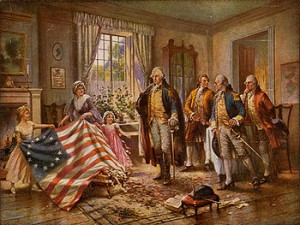On this day in 1836, the woman widely credited with making the first American flag, Betsy Ross, died in Philadelphia, Pennsylvania at the age of 84. Born Elizabeth Griscom on 1 January 1752 in Philadelphia. Ross married three times; John Ross (1773 – 1775 his death), Joseph Ashburn (1777 – 1782 his death), John Claypoole (1783 – 1817 his death). 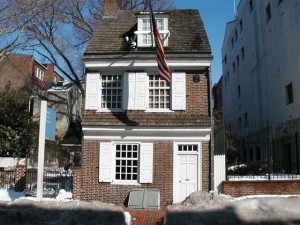
The Final Footprint – Ross’s body was first buried at the Quaker burial ground on South 5th Street in Philadelphia. Twenty years later, her remains were exhumed and reburied in the Mt. Moriah Cemetery in the Cobbs Creek Park section of Philadelphia. In preparation for the United States Bicentennial, the city ordered the remains of Ross and her third husband, John Claypoole, moved to the courtyard of the Betsy Ross House in Philadelphia in 1975; however, workers found no remains under her tombstone. Bones found elsewhere in the family plot were deemed to be hers and were re-interred in the current grave visited by tourists at the Betsy Ross House.
#RIP #OTD in 1948 Indian lawyer, anti-colonial nationalist, political ethicist who employed nonviolent resistance to lead the campaign for India’s independence, Mahātmā Gandhi; assassinated by gunshots; Birla House (now Gandhi Smriti), New Delhi, aged 78. Cremated remains immersed/scattered: Sangam at Allahabad; at the source of the Nile River near Jinja, Uganda; Girgaum Chowpatty. An urn is at the palace of the Aga Khan in Pune and another in the Self-Realization Fellowship Lake Shrine in Los Angeles. The place near Yamuna river where he was cremated is the Rāj Ghāt memorial in New Delhi. All heads of state are brought here to lay garlands in his memory.
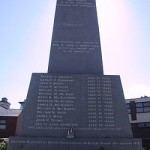 On this day in 1972, in the Bogside area of Derry, Northern Ireland, 26 civil-rights protesters and bystanders were shot by soldiers of the British Army. Thirteen males, seven of whom were teenagers, died immediately or soon after, while the death of another man four-and-a-half months later was attributed to the injuries he received on that day. Two protesters were also injured when they were run down by army vehicles. Five of those wounded were shot in the back. The incident occurred during a Northern Ireland Civil Rights Association march; the soldiers involved were members of the First Battalion of the Parachute Regiment (1 Para). Two investigations have been held by the British government. The Widgery Tribunal, held in the immediate aftermath of the event, largely cleared the soldiers and British authorities of blame. Widgery described the soldiers’ shooting as “bordering on the reckless” but was widely criticised. The Saville Inquiry, chaired by Lord Saville of Newdigate, was established in 1998 to reinvestigate the events. Following a 12-year inquiry, Saville’s report was made public on 15 June 2010. The report found that all of those shot were unarmed, and that the killings were both “unjustified and unjustifiable.” On the publication of the Saville report the British prime minister, David Cameron, made a formal apology on behalf of the United Kingdom. The Provisional Irish Republican Army’s (IRA) campaign against the partition of Ireland had begun in the two years prior to Bloody Sunday, but public perceptions of the day boosted the status of, and recruitment into, the organisation. Bloody Sunday remains among the most significant events in the Troubles of Northern Ireland, chiefly because those who died were shot by the British army rather than paramilitaries, in full view of the public and the press.
On this day in 1972, in the Bogside area of Derry, Northern Ireland, 26 civil-rights protesters and bystanders were shot by soldiers of the British Army. Thirteen males, seven of whom were teenagers, died immediately or soon after, while the death of another man four-and-a-half months later was attributed to the injuries he received on that day. Two protesters were also injured when they were run down by army vehicles. Five of those wounded were shot in the back. The incident occurred during a Northern Ireland Civil Rights Association march; the soldiers involved were members of the First Battalion of the Parachute Regiment (1 Para). Two investigations have been held by the British government. The Widgery Tribunal, held in the immediate aftermath of the event, largely cleared the soldiers and British authorities of blame. Widgery described the soldiers’ shooting as “bordering on the reckless” but was widely criticised. The Saville Inquiry, chaired by Lord Saville of Newdigate, was established in 1998 to reinvestigate the events. Following a 12-year inquiry, Saville’s report was made public on 15 June 2010. The report found that all of those shot were unarmed, and that the killings were both “unjustified and unjustifiable.” On the publication of the Saville report the British prime minister, David Cameron, made a formal apology on behalf of the United Kingdom. The Provisional Irish Republican Army’s (IRA) campaign against the partition of Ireland had begun in the two years prior to Bloody Sunday, but public perceptions of the day boosted the status of, and recruitment into, the organisation. Bloody Sunday remains among the most significant events in the Troubles of Northern Ireland, chiefly because those who died were shot by the British army rather than paramilitaries, in full view of the public and the press.
The Dead
- John (Jackie) Duddy. Shot in the chest in the car park of Rossville flats. Four witnesses stated Duddy was unarmed and running away from the paratroopers when he was killed. Three of them saw a soldier take deliberate aim at the youth as he ran. He is the uncle of the Irish boxer John Duddy.
- Patrick Joseph Doherty. Shot from behind while attempting to crawl to safety in the forecourt of Rossville flats. Doherty was the subject of a series of photographs, taken before and after he died by French journalist Gilles Peress. Despite testimony from “Soldier F” that he had fired at a man holding and firing a pistol, Widgery acknowledged that the photographs showed Doherty was unarmed, and that forensic tests on his hands for gunshot residue proved negative.
- Bernard McGuigan. Shot in the back of the head when he went to help Patrick Doherty. He had been waving a white handkerchief at the soldiers to indicate his peaceful intentions.
- Hugh Pius Gilmour. Shot through his right elbow, the bullet then entering his chest as he ran from the paratroopers on Rossville Street. Widgery acknowledged that a photograph taken seconds after Gilmour was hit corroborated witness reports that he was unarmed, and that tests for gunshot residue were negative.
- Kevin McElhinney. Shot from behind while attempting to crawl to safety at the front entrance of the Rossville Flats. Two witnesses stated McElhinney was unarmed.
- Michael Gerald Kelly. Shot in the stomach while standing near the rubble barricade in front of Rossville Flats. Widgery accepted that Kelly was unarmed.
- John Pius Young. Shot in the head while standing at the rubble barricade. Two witnesses stated Young was unarmed.
- William Noel Nash. Shot in the chest near the barricade. Witnesses stated Nash was unarmed and going to the aid of another when killed.
- Michael M. McDaid. Shot in the face at the barricade as he was walking away from the paratroopers. The trajectory of the bullet indicated he could have been killed by soldiers positioned on the Derry Walls.
- James Joseph Wray. Wounded then shot again at close range while lying on the ground. Witnesses who were not called to the Widgery Tribunal stated that Wray was calling out that he could not move his legs before he was shot the second time.
- Gerald Donaghey. Shot in the stomach while attempting to run to safety between Glenfada Park and Abbey Park. Donaghey was brought to a nearby house by bystanders where he was examined by a doctor. His pockets were turned out in an effort to identify him. A later police photograph of Donaghey’s corpse showed nail bombs in his pockets. Neither those who searched his pockets in the house nor the British army medical officer (Soldier 138) who pronounced him dead shortly afterwards say they saw any bombs. Donaghey had been a member of Fianna Éireann, an IRA-linked Republican youth movement. Paddy Ward, a police informer who gave evidence at the Saville Inquiry, claimed that he had given two nail bombs to Donaghey several hours before he was shot dead.
- Gerard (James) McKinney. Shot just after Gerald Donaghey. Witnesses stated that McKinney had been running behind Donaghey, and he stopped and held up his arms, shouting “Don’t shoot! Don’t shoot!”, when he saw Donaghey fall. He was then shot in the chest.
- William Anthony McKinney. Shot from behind as he attempted to aid Gerald McKinney (no relation). He had left cover to try to help Gerald.
- John Johnston. Shot in the leg and left shoulder on William Street 15 minutes before the rest of the shooting started. Johnston was not on the march, but on his way to visit a friend in Glenfada Park. He died 4½ months later; his death has been attributed to the injuries he received on the day. He was the only one not to die immediately or soon after being shot.
The Final Footprint – A Bloody Sunday memorial was erected in the Bogside. Paul McCartney (who is of Irish descent) recorded the first song in response only two days after the incident. The single entitled “Give Ireland Back to the Irish”, expressed his views on the matter. It was one of a few McCartney solo songs to be banned by the BBC. The John Lennon album Some Time in New York City features a song entitled “Sunday Bloody Sunday”, inspired by the incident, as well as the song “The Luck of the Irish”, which dealt more with the Irish conflict in general. Lennon, who was of Irish descent, also spoke at a protest in New York in support of the victims and families of Bloody Sunday. The incident has been commemorated by Irish band, U2, in their 1983 protest song “Sunday Bloody Sunday”. Black Sabbath‘s Geezer Butler (also of Irish descent) wrote the lyrics to the Black Sabbath song “Sabbath Bloody Sabbath” on the album of the same name in 1973. Butler stated, “…the Sunday Bloody Sunday thing had just happened in Ireland, when the British troops opened fire on the Irish demonstrators… So I came up with the title ‘Sabbath Bloody Sabbath’, and sort of put it in how the band was feeling at the time, getting away from management, mixed with the state Ireland was in.”
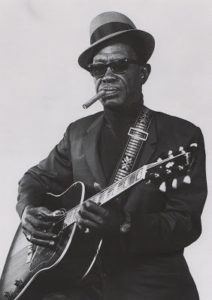 On this day in 1982, country blues singer, songwriter, guitarist, and musician Lightnin’ Hopkins died of esophageal cancer in Houston, at the age of 69. Born Samuel John Hopkins on March 15, 1912 in Centerville, Texas. He made his debut at Carnegie Hall on October 14, 1960, alongside Joan Baez and Pete Seeger, performing the spiritual “Mary Don’t You Weep”. In 1960, he signed with Tradition Records. The recordings which followed included his song “Mojo Hand” in 1960.
On this day in 1982, country blues singer, songwriter, guitarist, and musician Lightnin’ Hopkins died of esophageal cancer in Houston, at the age of 69. Born Samuel John Hopkins on March 15, 1912 in Centerville, Texas. He made his debut at Carnegie Hall on October 14, 1960, alongside Joan Baez and Pete Seeger, performing the spiritual “Mary Don’t You Weep”. In 1960, he signed with Tradition Records. The recordings which followed included his song “Mojo Hand” in 1960.
In 1968, Hopkins recorded the album Free Form Patterns, backed by the rhythm section of the psychedelic rock band 13th Floor Elevators. Through the 1960s and into the 1970s, he released one or sometimes two albums a year and toured, playing at major folk music festivals and at folk clubs and on college campuses in the U.S. and internationally. He toured extensively in the United States and played a six-city tour of Japan in 1978. Hopkins was Houston’s poet-in-residence for 35 years.
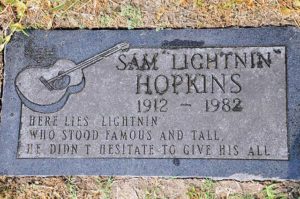 The Final Footprint
The Final Footprint
Lightnin’ is interred at Forest Park Lawndale Cemetery, Houston (a Dignity Memorial property) Garden of Gethsemane. His epitaph reads:
HERE LIES LIGHTNIN’
WHO STOOD FAMOUS AND TALL
HE DIDN’T HESITATE TO GIVE HIS ALL
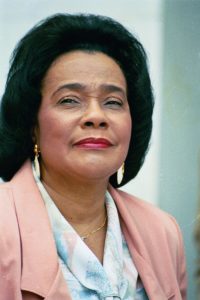 On this day in 2006, author, activist, civil rights leader, and the wife of Martin Luther King Jr., the “First Lady of the Civil Rights Movement” Coretta Scott King died of respiratory failure due to complications from ovarian cancer at a rehabilitation center in Rosarito Beach, Mexico, at the age of 78. Born on April 27, 1927 in Marion, Alabama. King met her husband while attending graduate school in Boston. They both became increasingly active in the American Civil Rights Movement. She was also a singer, and often incorporated music into her civil rights work.
On this day in 2006, author, activist, civil rights leader, and the wife of Martin Luther King Jr., the “First Lady of the Civil Rights Movement” Coretta Scott King died of respiratory failure due to complications from ovarian cancer at a rehabilitation center in Rosarito Beach, Mexico, at the age of 78. Born on April 27, 1927 in Marion, Alabama. King met her husband while attending graduate school in Boston. They both became increasingly active in the American Civil Rights Movement. She was also a singer, and often incorporated music into her civil rights work.
King played a prominent role in the years after her husband’s assassination in 1968 when she took on the leadership of the struggle for racial equality and became active in the Women’s Movement. King founded the King Center and sought to make his birthday a national holiday. She succeeded when Ronald Reagan signed legislation which established Martin Luther King, Jr. Day on November 2, 1983. She later broadened her scope to include both opposition to apartheid and advocacy for LGBT rights. King became friends with many politicians before and after Martin Luther King’s death, including John F. Kennedy, Lyndon B. Johnson, and Robert F. Kennedy. Her telephone conversation with John F. Kennedy during the 1960 presidential election has been credited by historians for mobilizing African-American voters.
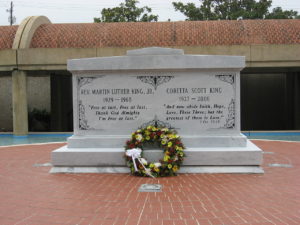 The Final Footprint
The Final Footprint
King’s eight-hour funeral at the New Birth Missionary Baptist Church in Lithonia, Georgia was held on February 7, 2006. Her daughter Bernice delivered her eulogy. U.S. Presidents George W. Bush, Bill Clinton, George H.W. Bush and Jimmy Carter attended. The Ford family was absent due to the illness of President Ford (who himself died later that year).
President Jimmy Carter and Rev. Joseph Lowery delivered funeral orations. King was temporarily laid in a mausoleum on the grounds of the King Center until a permanent place next to her husband’s remains could be built. She had expressed to family members and others that she wanted her remains to lie next to her husband’s at the King Center. On November 20, 2006, the new mausoleum containing the bodies of the Kings was unveiled in front of friends and family. The mausoleum is the third resting place of Martin Luther King and the second of Coretta Scott King.
Have you planned yours yet?
Follow TFF on twitter @RIPTFF

